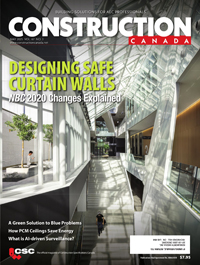Banff timber footbridge boosts regional appeal with low environmental impact
The specified slider id does not exist.
The Nancy Pauw Bridge, a recently erected footbridge over the Bow River, connecting Central Park to the Banff Recreation Grounds in Alberta, amplifies the beauty of the Rocky Mountain landscape, with minimal impacts to the river and the environment.
Not only does this bridge establish a significant connection between the two essential infrastructure elements within the town, but it also serves as a captivating destination, offering Banff residents and visitors a fresh perspective on the mesmerizing beauty of the river and the mountain landscape.
Like its downstream counterpart, the Nancy Pauw Bridge boasts an impressive 80-m (262-ft) clear span over the Bow River. This structure features an exceptionally shallow and pure arched design, constructed using stepped glue-laminated timber (glulam) girders and weathering steel haunches. The bridge was prefabricated into two sections, which were assembled simultaneously.
The design and construction of this slender, long-span timber bridge was by the B.C. structural engineering and building firm, StructureCraft. The Nancy Pauw Bridge marks the third pedestrian bridge that StructureCraft has designed and built for Banff, following the Muskrat Street Pedestrian Bridge and the Legacy Trail Footbridge in 2013.
One of the key objectives for the bridge was to minimize its impact on the river by achieving a clear span. In addition, it needed to have a low-profile design to ensure accessibility for users. The desired outcome was a bridge that harmoniously blends with the surrounding beauty while providing unobstructed views during crossings. However, the challenge was whether any material, let alone timber, could achieve the desired level of elegance.
The solution was implementing a shallow arch design to mimic the natural form of a tapered arch. The first challenge to address were the soil conditions, for which StructureCraft created abutments consisting of pile caps and large diameter piles anchored into the sturdy soil. Tapered weathering steel “haunches” were attached to the abutments, providing both additional stiffness and protection for the timber from the river. Diagonal steel bracing interconnected the two sets of Glulam girders, forming a diaphragm to resist lateral movements.
Drawing from the success of the well-designed guardrail and decking system used in the downstream bridge, a similar approach was adopted for the Nancy Pauw Bridge.
Designing a slender bridge posed challenges in terms of vibration performance. The shallow arch design made it difficult to predict the natural frequencies, which were closely spaced and compounded each other. To address this, a central tuned mass damper was employed, akin to the previous bridge. It consisted of a simple mass of steel plates suspended from cables attached to four points on the girders. Notably, this design could be tuned to suppress large initial accelerations in both walking (1.9 Hz 1st vertical) and jogging (2.4 Hz 1st torsional) frequencies. The mass moved vertically for walking and laterally for jogging, effectively dampening vibrations. However, the bridge retains a somewhat dynamic character.
As with any long-span bridge, the design had to consider erection, fabrication constraints, and the site’s environmental impact. Various levels of approvals and environmental impact assessments were successfully obtained under the design-build contract, with the client providing invaluable co-operation to meet critical timelines.
To span the river, the chosen erection scheme involved the concurrent installation of two bridge sections, each measuring 40 m (131 ft) in length and weighing 32,000 kg (70,550 lbs). A central tight-fitting thrust hinge was utilized during the initial installation, and the girders were later secured using straps.
To streamline the process and minimize handling, the long-tapered glulam pieces were manufactured and coated at the glulam plant, and then directly transported to the site. Onshore, they were assembled into two half-bridge sections in preparation for erection.
Due to the inherent nature of the shallow arch design, stringent tolerances were essential. Even minor horizontal displacements could result in significant vertical movements, and the bridge’s geometry relied heavily on achieving a precise fit. The erection of the bridge sections, involving the activation of the arch thrust, was completed within a matter of hours. Remarkably, the measured horizontal and vertical deflections, even after the structure had settled, were smaller than anticipated.


